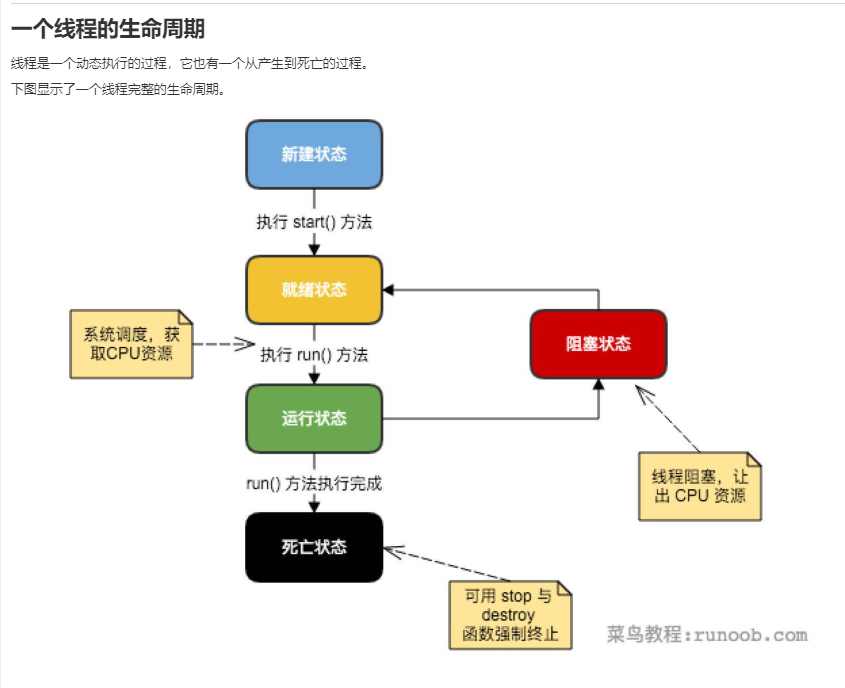线程类
计算机运行多个程序是多进程运行,比如一边打LOL一边听网易云。cpu其实一个时间只做一样事情,但是由于转换的时间非常短,让用户感觉cpu是在同时做多件事。我们的计算机运行一个程序时,程序中可以创建多个线程。程序是进程,程序中又可以创建线程,所以线程是比进程小的运行单位。程序为什么要创建线程呢?据我所知,程序中的代码都是顺序执行的,就是从上往下一条一条执行的。当一条卡住时,下一条就不能执行了,叫做线程阻塞。之前学到过,许多语句都会发生线程阻塞,比如scanner.hasNext(),serverSocket.accept(),还有最简单的线程阻塞就是while(true){}。如果线程发生阻塞,那下面的语句将没有机会获得cpu资源。从这个角度来说,如果把任务分为多个小任务,几个小任务排队共享cpu资源,一个任务代表一个线程,不同的线程不会发生阻塞,也就是线程之间不会相互影响。这里是不是要担心排队也会等待过久让后面的线程无法得到cpu资源呢?其实不用担心,我们可以设置线程的优先级,同一优先级的线程会均匀分配cpu资源的,具体怎么分的不太清楚。。
public class Test{
public static void main(String args[]){
while(true){
System.out.println("hello");
}
}
}
程序会一直输出hello
一个主方法运行时,就被分配了一个主线程。由于只有一个线程,这个程序就是单线程的。
冷知识:如果这是你在while循环后面加上语句时,idea会报错说这些语句是无法到达的。
但是像下面这种,其实也是无法到达的。
import java.util.Scanner;
public class Test{
public static void main(String args[]){
Scanner scanner = new Scanner(System.in);
while (scanner.hasNext()){
System.out.println(scanner.nextLine());
}
int r = 2;
int a = 8;
System.out.println(a*r);
}
}
看看下面这个程序,两个while循环同时运行输出的,说明他们是在共享cpu资源。
public class Test{
public static void main(String args[]){
jisuan multi = new jisuan();
Thread thread = new Thread(multi);
thread.start();
Thread thread1 = new Thread();
while (true){
System.out.println("happy");
try {
thread1.sleep(1000);
} catch (InterruptedException e) {
e.printStackTrace();
}
}
}
}
class jisuan implements Runnable{
@Override
public void run() {
Thread thread = new Thread();
int r = 2;
int a = 1;
while ( a <= 10){
System.out.println(a * r);
a++;
try {
thread.sleep(1000);
} catch (InterruptedException e) {
e.printStackTrace();
}
}
}
}
如何创建一个线程类?
方法一,继承Thread,重写public void run()方法
方法二,实现Runnable,实现其run()方法。
在一个线程中可以加入其他线程,方法是先创建一个线程类对象,然后将这个线程对象作为参数新建一个Thread对象,使用Thread对象调用start()方法启动线程,该线程就已经开始排队请求cpu资源了,当被分配到cpu资源时自动执行run()方法。
方法将由系统自动调用而不再用户调用。
重新看了一遍菜鸟教程的多线程,虽然内容不多,但是还是由收获的。
学习线程先学习线程的生命周期

然后创建线程的方法,也就是Thread类的构造方法。Java的万物皆对象,在这里,线程就是Thread类的对象。但是Tread类中的run()方法就啥也没有,所以我们要继承Thread类去写自己的run()方法,其他方法也可以重写。如果使用的是实现Runnable接口的方法创建线程,需要使用到Thread的另外一个构造方法,就是Thread thread = new Thread(Rannable rannable)。Thread对象中由许多方法,最重要的方法就是start()方法,它可以让线程从新建状态变成就绪状态。run()方法由JVM调用。
public class Test{
public static void main(String args[]){
jisuan ji = new jisuan();
Thread thread = new Thread(ji,"niaho");
System.out.println(thread.getName());
thread.start();
while (true){
System.out.println("happy");
try {
Thread.sleep(1000);
} catch (InterruptedException e) {
e.printStackTrace();
}
}
}
}
class jisuan implements Runnable{
@Override
public void run() {
int r = 2;
int a = 1;
while ( a <= 10){
System.out.println(a * r);
a++;
try {
Thread.sleep(1000);
} catch (InterruptedException e) {
e.printStackTrace();
}
}
}
}
继承Thread类
public class Test{
public static void main(String args[]){
jisuan jisuan = new jisuan();
jisuan.start();
while (true){
System.out.println("happy");
try {
Thread.sleep(1000);
} catch (InterruptedException e) {
e.printStackTrace();
}
}
}
}
class jisuan extends Thread{
@Override
public void run() {
int r = 2;
int a = 1;
while ( a <= 10){
System.out.println(a * r);
a++;
try {
Thread.sleep(1000);
} catch (InterruptedException e) {
e.printStackTrace();
}
}
}
}


